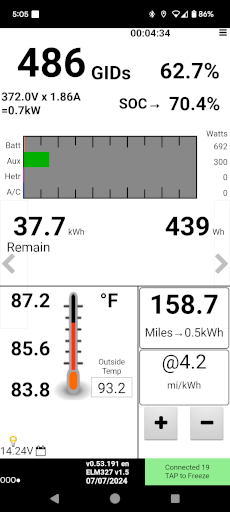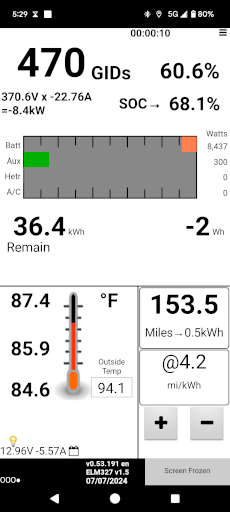Did another "let it sit and then drive" test today. This time, I was able to get better measurements of the ice. So, I started with a 7 lb (3.2 kg) bag of ice at 0 F (-17.8 C). Took a quick LeafSpy battery temperature screen-shot. Shoved all the ice into the cavity, bolted it down.
Came back about an hour later, get another temperature reading. Can confirm cooling effect again, even with rising outside temperatures. Lots of water leaking out the back.

Then drove around for half an hour doing errands but after only 30 minutes, the ice was gone at that point. Temperatures starting to go back up.

So far, I have not determined the maximum amount of ice that can be shoved into the cavity yet, but I feel I am getting close.

The cooling effects work best when the Leaf is not moving, otherwise the ice only seems to work for about an hour before it is all melted and blown out the back with 7 lb (3.2 kg) of ice at least.

While the results of these experiments are interesting, I'm not sure how practical it is to try and use this.
- First issue is that the cavity needs to be air tight, which means having to bolt the cover down after you fill it with ice. It's not difficult with the right tool, but then you'll need to carry a ratchet, extension arm, and 10 mm bit all the time.

- Getting all the ice in takes a little hand work to shove it around to the edges to allow more ice to flow in.
- Bags of ice cost money, but are fairly cheap and easy to get at least.

- The cooling effect is basically gone in an hour of driving, but last much longer if the Leaf is just sitting still, even in hot weather it works longer this way.
- The cooling effect takes time, so dumping in a bag of ice and then doing an immediate QC session might not be useful. Still waiting to test this...

Just some napkin math, but if you have a road trip ahead and you need to keep the battery cool, it's basically a 7 lb (3.2 kg) bag of ice per hour. So either you would need a big cooler with a bunch of bags to keep dumping in or some kind of device would have to be created so you can replace the metal bolted piece with something that is air sealed and faster and easier to open or close to dump in more ice like a door or twist cap. If the space above the cavity would be bridged, a lot more ice could be dumped in, probably double the amount to flow in as it melts. So my guess would be even with that extra space you'll be putting in more ice every 2 hours if the weather is really hot outside. The benefits would be though that arriving at a QC station with a battery that is in the low 80s F (26.7 C) or high 70s F (21.1 C) for temperature is a lot faster than arriving with a battery way above +100 F (37.8 C) to +110 F (43.3 C) doing a QC because it would be really slow.







